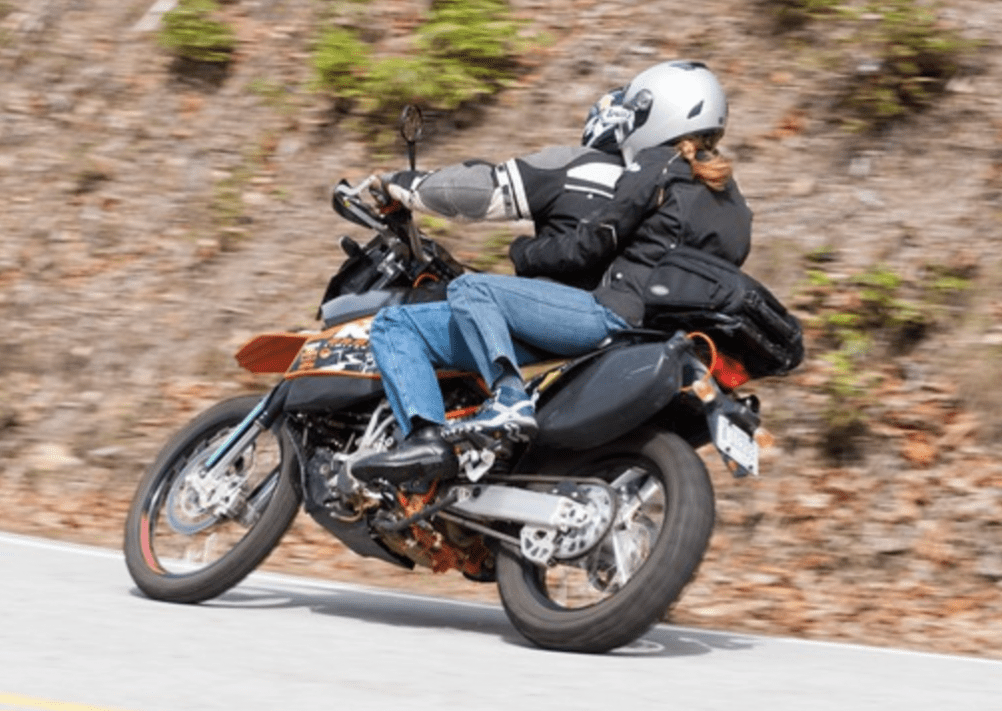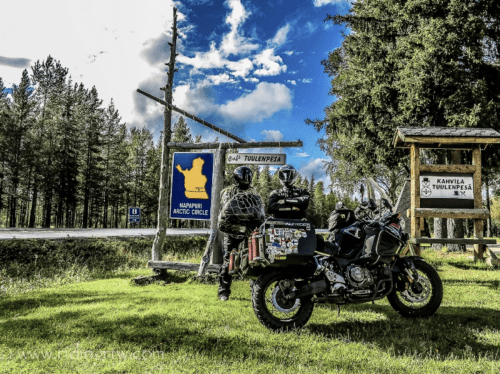
The Two Rules of Being a Great Pillion
BY: SARA PARLIER
There’s not a wealth of information out there about how to be a good passenger on a motorcycle. To be frank, I dislike a lot of it. I believe those of us who have (happily, mind you) racked up thousands of miles on the back of a motorcycle have a different perspective on this than someone who is strictly a rider.
Riding as a passenger on a motorcycle, especially after you leave the smooth pavement, is something that takes trust and respect from both parties. It should always be treated this way.
To all of you who are just beginning or looking to be a better passenger – here’s some advice from a seasoned, happy, on-and-off-road pillion about how to build a great relationship with your rider. And it’s EASY! There are just two rules. Are you ready?

The Rules
Rule # 1 –
Throw out almost everything you have read or been told about how to be a good pillion.
I’m not kidding. Start there.
I hear you. You’re saying, “What?! Sara, that’s the dumbest thing I’ve ever read!”
Bear with me. The Number one key to being a great passenger on a motorcycle is to leave off the advice and input from anyone but YOUR RIDER.
I’d like to repeat that.
What YOUR PRESENT RIDER – not your rider two years ago, but today – needs from you as a passenger is the most important thing. Communicate with them.
Before your ride, talk about what they like and what they don’t and where your comfort level is. It’s no good if you’re distracting them with something you think is helpful, and they’re scaring the pants off you riding at a level you are not comfortable with.
Talk about as much of this as makes sense before you ever get on the bike. Work out some signals that you two of you agree on. Much of your bike-speak will come naturally with time, but sorting out a few simple things at the start can be the difference between an enjoyable trip and a frustrating ride.
If you’ll get answers to the following, you’ll be ahead of the game:
(I’ve included what works for my usual rider and myself in parenthesis)
- Their signal to you when they’re ready for you mount the bike. (Eye contact and a single nod for us.)
- Your signal to them when you’re settled and ready to ride. (Two taps on his sides with both hands for me).
- Their signal to ‘hold on’ for passing or similar. (Either pressing of my hand already on his midsection or him tapping on my left knee or just grabbing my hand if I’m not already in contact with him).
- Your signal to get their attention for stops or adjustments. (Several gentle pokes in his right side for us – accompanied by whatever gesture communicates my need – pointing at a fuel station or wherever I’d like to stop and similar).
- Their signal to you when they’re ready for you to dismount the bike. (Visors are usually up so he just says, ‘okay’ and nods).
Break stops are a great time to ask your rider what they felt worked or if anything annoyed them. Try to listen to any input without being offended. This communication is how the relationship is built. If you want a rider who brags on what a great passenger you are – this is how it happens.
You should also talk about what you felt was hard or you did or didn’t like. If your rider is someone you’re close with, your experience is going to be important to them. If it’s a one-off ride or a group situation, you may find people who aren’t receptive, don’t care or that you’re not compatible with. That’s fine. Make the best of this day’s ride and go on your way!
Also please remember, you have rights as a passenger. You should feel safe and respected. If a rider suggests you should just jump on without proper gear or are being a ‘chicken’ about how hard they like to ride, it’s not a good fit. Occasionally this happens with your ‘regular’ rider, and there are conversations to be had. If it’s a friend or one-off situation, I generally let it go as best I can and don’t choose to ride with that person again if it can be helped.
Rule #2
Pay attention as though you are the rider.
While it’s nice to have a look at the scenery, you need to be aware of what’s ahead just as if you were riding.
All riders have different ideas about how they want you to handle curves, passing other vehicles and etc as a passenger. This is why Rule #1 is so important. You need to know not only what they want you to do, but how and WHEN it’s applicable. If you’re not paying attention, all of the chatting beforehand or at lunch is for naught.
This one is simple. Be alert and be aware to be safe – with one caveat. If you are currently a rider on your own, remember, you’ll have to check some of your instincts. Not stabbing your foot down when you think it’s needed or similar can be difficult. Have this top-of-mind. You need to enjoy this ride as passenger and let the rider do their thing!

TIPS/ DO’s and DON’Ts
Now that we have the rules out of the way – I can give you some a) VERY general tips/info and b) definite DO NOTS. Please don’t expect this to be an exhaustive list of tips. I hope I’ve made clear that the communication you have with your rider and respect/response to their requests is really all you need to ride successfully as a pillion!
1) Hand/BodyPlacement
Very basic, but worth covering for new passengers. After you’ve waited for your rider’s signal to mount (and remember wait for their signal to dismount as well):
DO – Keep your hands low and out of the rider’s periphery unless you’re signaling something to them. Appropriate places for them to rest for comfortable riding may be the rider’s midsection, your thighs, grab bars, or some combination of these.
DO – Be aware of your foot placement. If your heels are resting on the foot pegs, you may find the rider’s leg bumping into your toes as they adjust to brake or change gears. Shift them back slightly to a position that is still comfortable for you and out of the rider’s way.
DON’T – Ride with your hands on the rider’s shoulders unless you the two of you agree this is a signal. Making large motions with your hands or arms is not suggested unless it’s an emergency. This is distracting and dangerous.
DON’T – Wiggle your body or legs around any more than necessary. Respect the rider and the work they’re doing to keep both of you off the ground.
2) Curves
This one frequently feels elusive to passengers, but is more simple than you might think.
DO – Be consistent. Some riders want you to lean. In my experience, this is very rare barring advanced riding. Most riders want you to stay with the bike (not the rider – they control the lean. Staying with them means you’re actively leaning – we’re looking for a passive lean here). Most also want you looking over the shoulder that corresponds with the curve (curve left, look over left shoulder) so that your weight is not fighting against them. But please always refer back to Rule #1 and go with your rider’s preferences here.
DON’T – change anything mid-corner. They’ve committed a lean angle based on what they’re feeling as they go in. Abrupt changes can be disastrous. If you’re not looking over the correct shoulder, stay where you are and be better prepared for the next one.
3) Discuss Braking
When a rider brakes with force (or gears down suddenly) and you’re unprepared, you’re going to slide right into him or her and enjoy a ‘helmet kiss’ (I HATE those!).
DO – plan ahead for success. Get familiar with passenger bars or handles if you have them, and figure out your strategy if you don’t. When approaching stops, be prepared and ready to hold your weight with the bars and into your feet if necessary to prevent jarring your rider.
I spent a long time with a rider who preferred that I have one hand on their midsection and one on the tank to brace during braking. I rode with another rider who’d had someone scratch their tank that way. He spent 10 minutes loudly lecturing me on how he’d rather me slam into him than scratch his paint since he had no passenger handles (reinforcing Rule #1 here). I didn’t enjoy this very much, and in fact only rode with him once, but still followed his request out of respect.
My current set-up for this varies with the situation, but always involves some combination of one or both hands on the handles (depending on intensity) and possibly shifting some of my weight into my feet depending on the situation.
DON’Ts – just let your weight fly into your rider shoving them into the tank, unless that’s their instruction. Also don’t try any new braking tactic, especially that involves touching the bike or the rider, without discussing it first. Again, this requires orchestration with your rider and improves with seat time together!
4) Slow speed handling
Only a ‘don’t’.
DON’T – make any abrupt shifts when moving at slow speed. Slow speed on the road or trail means something is tricky. Pay attention and be as flexible and neutral as possible.
Slow speed approaching a stop is also unstable. It is very difficult for the rider if you take this time to adjust your pants or seat position. Save that for when you’re moving on a straight stretch.
Also keep in mind that when at a stop, especially on a hill, the rider is likely balancing the weight of the bike and you on just part of their feet – or even one foot if holding the rear brake for a hill. This is NOT the time to move. Relax and wait until you are under speed to make any adjustments.
5) ADV Riding together
As soon as you start riding off-road together, things change drastically. The way that the bike behaves on surfaces other than asphalt is something you’ll have to get used to, and every surface has its own different challenges.
If you’re new to this type of riding, you may not know that your rider will have the need to stand up quite often to better control the bike. How you guys handle this situation is also individual.
There are some teams who ride with both rider and pillion standing. They are able to get through some incredibly technical terrain this way. However, this is fairly tricky and, as with everything else, is something you and your rider have to sort through together.
If you find you’re unexpectedly on gravel or similar, I’d recommend planting your backside and staying with the bike as best you can. If you have some experience with getting your weight out of the seat, you may strategically use this to lessen bumps from holes and etc in the path. Let the rider handle all the maneuvering and enjoy the trip! It really can be a blast!
Also, there may be times when you rider needs you to dismount and walk ahead so that they can traverse a tricky obstacle or stretch. DO NOT get your feelings hurt by this one! This is normal and usual in this type of riding. Hop off, walk ahead and give a big thumbs-up when they get through the tricky stretch. (Not to mention having a chance to stretch your legs for a few can be very nice!)
Remember, if at any time your rider is heading into terrain you’re uncomfortable with or unsure how to handle, you should stop them and have a quick chat before heading on. Try to cover as much as you can in one go, asking about as much of the upcoming terrain as you can – as frequent stopping like this is not going to be welcome. Worst case, when in doubt, staying with the bike and as flexible and neutral as possible is always best.
A quick note to the riders: if you aren’t comfortable with or don’t care to have a pillion, I totally get it! Just don’t take them if it can avoided. Begrudging someone a ride doesn’t wind up being fun for anyone.
The advice columnist in me says, “If you don’t care for pillions but compromise for the sake marital or relational harmony, then run with it. Find the parts that of sharing this ride together that you enjoy, and focus on those rather than the parts that are more awkward or frustrating. It’s unfair to both parties if you agree to the ride only to be bitter about it later.” Realistic expectations by all make for a much better situation all around.
I hope this gives you new and always-learning pillions a few things to chew on as to how you can work with your rider to create an incredible team. For all the riders out there who’ve resisted being a pillion – maybe you’ll give it a try. You should go read about Egle’s experiences 2-up as well! Or go search the site for ‘pillion’ and see all the great teams we’ve featured. It can be a lot of fun to travel this way with someone else, and experience the ride from a different seat once you have the trust and respect in place!
